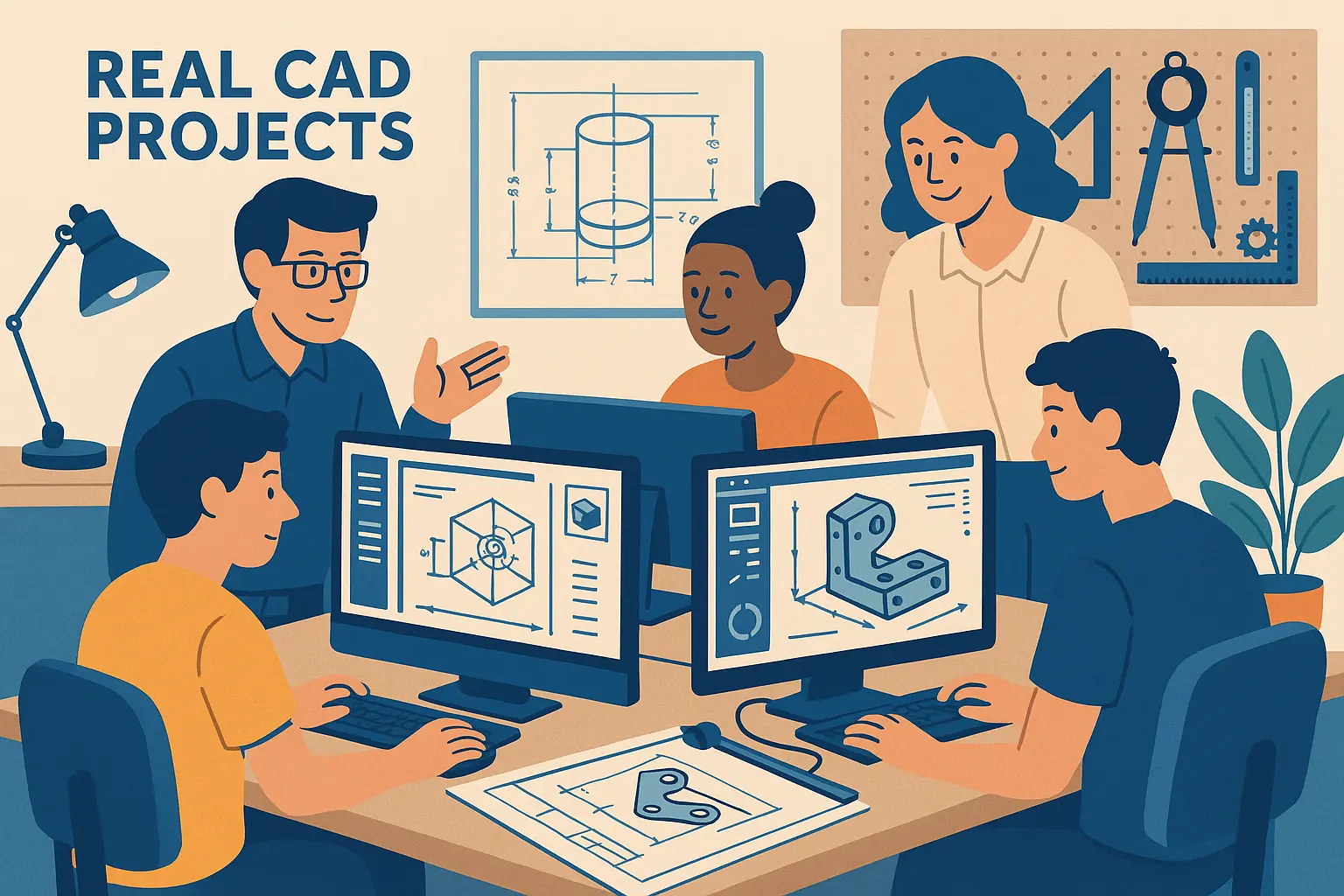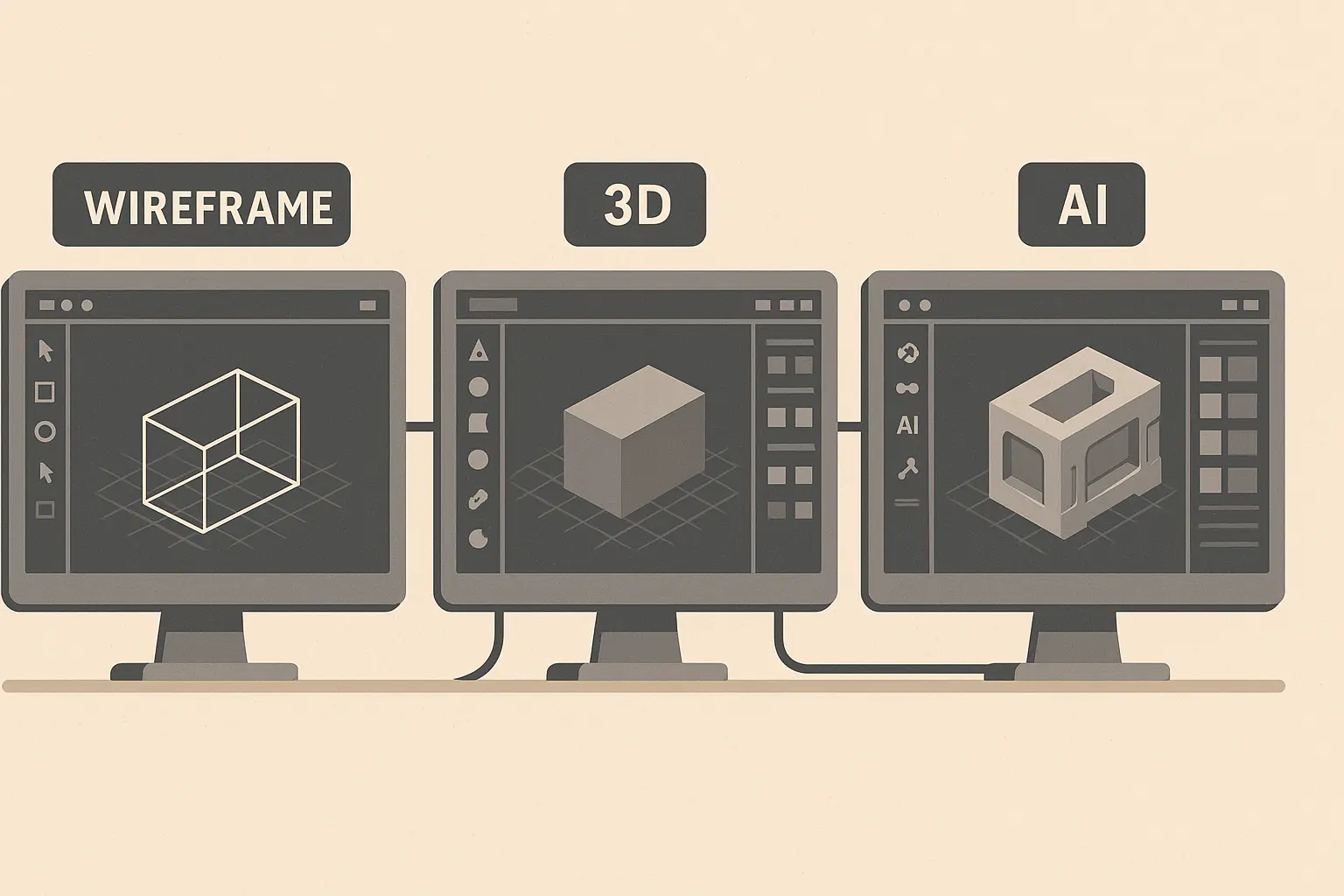The traditional answer of “2-4 years” for a CAD degree barely scratches the surface of what’s actually possible in today’s rapidly changing educational landscape. With programs that care more about what you can do than how long you sat in class, and basic CAD skills achievable in just 20 hours of focused study, the real question isn’t how long a degree takes—it’s how to navigate the different pathways that can speed up or slow down your timeline.

Table of Contents
-
The Skills-First Learning Revolution
-
Location and Learning Format: Your Timeline Game-Changers
-
Money Moves That Speed Up (or Slow Down) Your Degree
-
Tech Timing: Why When You Start Actually Matters
-
The Real Timeline Breakdown Nobody Talks About
-
Final Thoughts
TL;DR
-
Programs that focus on skills over seat time can cut your degree time by 30-50% if you already know CAD
-
International programs offer 18-month intensive options that US schools typically don’t
-
Employer sponsorship creates custom timelines that work with business needs
-
Starting your program around major software releases affects how relevant your education will be
-
Associate degrees range from 18 months to 4 years depending on your situation
-
Portfolio reviews and industry certifications can dramatically reduce completion time
-
Smart financial aid strategies let you study year-round for faster graduation
The Skills-First Learning Revolution
In my experience helping students navigate CAD programs, I’ve noticed a major shift over the past few years. We’re moving away from the old “sit in class for X semesters” model toward programs that actually care about what you can do rather than how long you’ve been doing it. This change means your existing skills, portfolio work, and industry certifications can seriously cut down the time it takes to earn your degree.
Programs now offer portfolio reviews, prior learning credits, and industry mentorship opportunities that can reduce completion time by months or even years. Understanding how long it takes to get a certificate can help you strategically plan your CAD education pathway, especially when considering micro-credentials and industry certifications.
According to Noble Desktop’s CAD learning analysis, gaining basic proficiency in CAD programs like AutoCAD typically requires about 20 hours of focused study, while reaching intermediate competence generally takes 6 to 12 months of dedicated learning and practice. When you’re thinking about how long it takes to get a CAD degree, these numbers become crucial for planning your educational strategy.
Skills-First Learning That Actually Works
Modern CAD programs focus on what you can actually demonstrate rather than classroom hours, creating flexible pathways where your existing knowledge directly impacts your timeline. Students who can prove their CAD skills through portfolios or work experience often skip foundational courses entirely.
This approach recognizes that learning happens everywhere. I’ve seen students with YouTube-taught skills and weekend project experience earn credit for advanced coursework. The key is documenting your abilities in ways that schools can evaluate and give you credit for.
Look, I’ll be honest – this isn’t a magic bullet. Some schools are still pretty traditional about this stuff, and not every employer loves these fast-track degrees. Some still prefer the traditional timeline approach.
Portfolio Power: Your Fast-Track Ticket
Some programs now evaluate comprehensive portfolios of your existing CAD work, potentially reducing program duration by 30-50%. This method acknowledges that many students enter CAD programs with self-taught skills, online course experience, or workplace knowledge that shouldn’t require repetition in formal education.
Sarah, a mechanical engineer with 5 years of SolidWorks experience, submitted her portfolio of 15 complex assembly projects to a skills-based CAD program. Her portfolio evaluation resulted in 24 credit hours of advanced standing, reducing her associate degree completion time from 24 months to 14 months while saving $8,000 in tuition costs.
That said, Sarah’s story sounds perfect, but she also told me she barely saw her family for those 14 months. The accelerated pace was intense, and she questioned whether it was worth the stress. Just something to keep in mind.

Industry Mentorship: Learning While Earning
CAD programs partnering with design firms create accelerated pathways where real-world project experience counts toward degree requirements. These arrangements benefit everyone – you gain practical experience and faster completion, while companies get access to emerging talent and potential future employees.
I’ve noticed these partnerships often result in job offers before graduation. Companies invest in your education because they want to hire you, creating a direct pipeline from classroom to career that traditional programs can’t match. But here’s the reality check – not every employer is willing to do this, and you might end up feeling obligated to stay with a company longer than you’d like.
Building Your Way to Success
Micro-credential stacking allows you to build CAD expertise step by step while working toward your full degree. This approach creates multiple exit points where you can start earning while continuing your education.
You can earn industry-recognized certifications that often transfer as degree credits, reducing overall program length while building your professional credentials at the same time. The nice thing about this system is that each certification has immediate value in the job market, so you’re not waiting until graduation to see returns on your educational investment.
Professional Certifications That Count
Industry-recognized certifications from companies like Autodesk or SolidWorks often transfer as degree credits, reducing your overall program length. These certifications also boost your employability immediately, even before you complete your degree.
|
Certification Type |
Credit Hours Awarded |
Time to Complete |
Cost Range |
|---|---|---|---|
|
Autodesk Certified User (AutoCAD) |
3-6 credits |
40-60 hours |
$150-$300 |
|
SolidWorks Associate (CSWA) |
6-9 credits |
80-120 hours |
$99-$200 |
|
Autodesk Certified Professional |
9-12 credits |
120-200 hours |
$300-$500 |
|
Advanced SolidWorks Professional |
12-15 credits |
200-300 hours |
$400-$700 |
These hours are estimates – some people pick this stuff up faster, others need more time. Don’t stress if you’re not hitting these numbers exactly. Also, cost ranges change constantly, so double-check before you commit to anything.
Location and Learning Format: Your Timeline Game-Changers
Where and how you pursue your CAD degree creates surprising variations in completion time that most students never think about. I’ve found that international programs offer intensive formats you can’t get in the US, while hybrid learning models and seasonal intensives can really change your educational timeline.
The key is understanding these options exist and choosing the format that actually works with your life and goals. Most students stick with local options without exploring alternatives that could save them months or even years.
International Fast-Track Options
Certain countries offer intensive CAD degree programs with dramatically different time structures than traditional US programs. These alternatives can provide solid education in compressed timeframes, though they require careful consideration of visa requirements, credit transfers, and cultural adjustments.
Before you get too excited about 18-month European programs, let’s talk about what that actually means for your daily life.
European Intensity: 18 Months to Degree
European institutions offer 18-month intensive CAD programs combining theoretical knowledge with extensive practical application. These programs pack traditional curriculum into accelerated formats through longer daily schedules and year-round study, appealing to students who want to enter the workforce quickly.
I’ve talked to graduates of these programs who describe them as demanding but incredibly focused. You’re essentially treating education as a full-time job with overtime, but the payoff is entering the job market 1-2 years earlier than your peers.
The flip side? International programs sound amazing until you factor in visa stress, being away from family, and the cultural adjustment. One student told me the academic pace was manageable, but dealing with bureaucracy in a foreign language nearly broke him.

Canadian Co-op: Extended but Paid
Canadian CAD programs often include mandatory co-op experiences that extend program length but provide paid work experience and potential job placement. While these programs take longer to complete, the built-in earning potential and job placement rates often justify the extended timeline.
The co-op model essentially guarantees you’ll graduate with work experience and industry connections. Many students receive job offers from their co-op employers, making the extended timeline worthwhile for the career security it provides.
Hybrid Learning That Makes Sense
Strategic combinations of online theoretical coursework with hands-on lab experiences can significantly impact program duration and flexibility. This approach allows you to complete theory work on your schedule while ensuring you get essential hands-on training with industry-standard equipment and software.
The increasing demand for powerful CAD workstations has led to significant hardware innovations. According to “Creative Bloq’s 2025 CAD laptop guide”, the new ASUS ProArt P16 with RTX 5070 graphics delivers desktop-class performance in portable form, enabling students to run complex CAD software anywhere and supporting more flexible hybrid learning schedules.
Seasonal Intensives: Accelerate During Breaks
Condensed summer or winter intensives allow students to accelerate their studies during traditional break periods. These programs require intense focus and commitment but can significantly reduce overall degree completion time for motivated students willing to sacrifice traditional vacation periods.
I’ve seen students knock out entire semesters worth of coursework in 6-8 week intensive sessions. The concentrated learning actually helps with retention since you’re not constantly switching between multiple subjects.
If you’re working 40+ hours a week and have kids, those intensive summer programs might sound appealing, but think hard about whether you can actually handle that pace. I also know a guy who tried to cram everything into one summer and ended up dropping out halfway through. The pressure was just too much while working full-time.
Money Moves That Speed Up (or Slow Down) Your Degree
Financial considerations create unique pathways that can either extend or compress CAD degree timelines in ways most students never anticipate. From what I’ve seen, employer sponsorship, revenue-sharing programs, and smart financial aid use can dramatically alter your educational timeline while potentially reducing your out-of-pocket costs.
Let’s be real – not everyone has an employer willing to sponsor their education. Most of us are figuring out how to pay for this ourselves. But understanding these financial strategies helps you make informed decisions about both timing and funding.
Employer-Sponsored Fast-Track Programs
Companies increasingly sponsor employees through accelerated CAD education programs, creating customized timelines based on business needs. These arrangements often result in faster completion times because employers want their investment to pay off quickly, leading to intensive but well-supported educational experiences.
Corporate Partnership Degrees
Some employers partner with educational institutions to create custom CAD programs running on accelerated schedules aligned with project cycles. These programs often feature guaranteed job placement and immediate application of learned skills, making the intensive timeline more manageable and relevant.
The best part about these partnerships is that your coursework directly relates to your current job responsibilities. You’re learning skills you’ll use immediately, which makes the accelerated pace feel natural rather than overwhelming. But Marcus had it figured out because he also had a really understanding boss. Not everyone’s that lucky.
Revenue-Share Educational Models
Emerging programs allow students to complete degrees faster by taking on real client work during their studies, with earnings offsetting tuition costs. This model creates motivation for efficient learning while providing practical experience and financial relief, though it requires strong time management skills.
You might be thinking, “This sounds too good to be true” – and honestly, sometimes it is. These programs work great when you have the right projects and clients, but they can fall apart if the work dries up or clients don’t pay on time.

Smart Financial Aid Planning
Strategic use of financial aid creates opportunities for year-round study that significantly reduces overall degree completion time. Many students don’t realize that specific grants and funding sources can support accelerated study schedules that traditional financial aid doesn’t cover.
Grant-Funded Acceleration
Specific grants for STEM education sometimes fund summer study programs not covered by traditional financial aid, allowing for faster completion. These opportunities require proactive research and application but can provide the financial support needed for intensive, accelerated study schedules.
Marcus leveraged a combination of employer tuition reimbursement and a state STEM acceleration grant to complete his CAD associate degree in 15 months instead of the standard 24. By attending classes year-round and working part-time at his sponsoring engineering firm, he graduated debt-free with immediate full-time employment and a 40% salary increase. But he also told me he barely had a weekend off for over a year. The money worked out great, but the work-life balance was rough.
Tech Timing: Why When You Start Actually Matters
Here’s something most people don’t think about: starting your program right when new software comes out can actually mess with your timeline. The rapid evolution of CAD technology makes the timing of your program start as important as its duration. Major software releases, emerging technologies like AI and VR, and industry disruptions all influence how relevant your education will be and how long your program takes.
I’ve seen students graduate knowing the old version of AutoCAD while everyone at work was using the new one. Talk about awkward.
The critical importance of technology timing was highlighted by the recent “LASD CAD system failure” on December 31, 2024, where an antiquated Computer Assisted Dispatch system completely failed, leaving law enforcement “dead in the water” and unable to run basic operations. This incident underscores how outdated CAD systems create operational disasters and emphasizes the need for current technology training in CAD education programs.
Software Generation Alignment
Starting CAD programs at specific times relative to major software releases can significantly impact the relevance and duration of your education. Programs often adjust their curriculum timing around software updates, potentially extending or compressing certain courses to ensure students learn the most current versions.
Next-Generation Software Preparation
Programs that anticipate major CAD software updates often adjust their curriculum timing, potentially extending or compressing certain courses. This forward-thinking approach ensures graduates enter the workforce with the most current software knowledge, though it can create timeline variations.
Smart programs will sometimes delay certain advanced courses by a semester to align with major software releases. While this might extend your timeline slightly, graduating with cutting-edge software skills often justifies the extra time through higher starting salaries.

Cloud-Based Learning Acceleration
Cloud-based CAD platforms enable 24/7 access to software and projects, potentially reducing traditional constraints of lab-based learning schedules. This technology allows for more flexible study schedules and can accelerate completion for self-motivated students who take advantage of constant access.
Industry Disruption Response Programs
CAD programs are adapting to emerging technologies like AI-assisted design and VR modeling, creating specialized tracks that may alter traditional degree timelines. These cutting-edge specializations often require additional coursework but position graduates for emerging market opportunities with higher earning potential.
AI Integration Specializations
New CAD programs incorporating artificial intelligence and machine learning components often require additional coursework that can extend traditional 2-year associate programs to 2.5-3 years. However, graduates with AI-CAD skills command premium salaries in an increasingly automated design industry.
The extra time investment pays off quickly when you consider that AI-enhanced CAD specialists often start at salaries 20-30% higher than traditional CAD graduates. The market demand for these skills is growing faster than educational programs can produce qualified graduates.
Virtual Reality Design Tracks
VR-focused CAD specializations typically add 6-12 months to standard programs but position graduates for emerging market opportunities. As industries adopt VR for design visualization and client presentations, these extended programs often justify their longer timelines through higher starting salaries.
That said, not every employer is jumping on the VR bandwagon yet. Make sure there’s actually demand in your area before committing to the longer timeline.

The Real Timeline Breakdown Nobody Talks About
Traditional CAD degree timelines follow predictable patterns, but hidden factors significantly alter these standard durations. Understanding the real variables affecting associate and bachelor’s degree completion helps you plan realistically and identify opportunities for acceleration.
Part-time study, transfer credits, and dual degree options all create timeline variations that can either extend or compress your educational journey. While considering CAD degree timelines, it’s helpful to understand how long it takes to get an associate degree in general, as many CAD programs follow similar patterns with unique variations.
According to El Camino College’s CAD program data, their Computer Aided Design/Drafting Associate in Science (AS) degree typically takes two years to complete, while students can earn a certificate in just six months to a year and be ready for entry-level positions with salary ranges from $35,000 to $115,000 and an average salary of $59,000.
Associate Degree Realities (18-24 months typical)
Most CAD associate degrees follow predictable timelines, but real-world factors can significantly alter these standard durations. Working professionals, transfer students, and those with prior experience often find their actual completion times differ substantially from what the brochures promise.
|
Student Type |
Typical Timeline |
Accelerated Options |
Potential Extensions |
|---|---|---|---|
|
Full-time Traditional |
18-24 months |
Portfolio credit: 12-18 months |
None |
|
Working Professional |
36-48 months |
Weekend intensives: 24-30 months |
Family obligations: 60+ months |
|
Military/Transfer |
12-18 months |
Prior learning assessment: 9-15 months |
Credit evaluation delays: 24+ months |
|
Career Changer |
24-30 months |
Bootcamp prep: 18-24 months |
Prerequisite courses: 36+ months |
Part-Time Professional Pathways (3-4 years)
Working professionals typically extend associate CAD programs to accommodate work schedules, but smart course planning can optimize this timeline. Understanding prerequisite chains and planning around intensive lab courses helps maintain momentum even with reduced course loads.
The biggest challenge I see with part-time students is losing momentum during semester breaks. Maintaining consistent progress, even if it’s just one course per term, keeps your skills sharp and prevents the need to relearn concepts.
If you’re working full-time, be realistic about what you can handle. I’ve seen too many people burn out trying to take three classes while working 50-hour weeks.
CAD Degree Planning Checklist for Working Professionals:
-
☐ Identify evening and weekend course availability
-
☐ Map prerequisite sequences to avoid bottlenecks
-
☐ Negotiate flexible work schedules for lab-intensive courses
-
☐ Explore employer tuition reimbursement programs
-
☐ Consider summer intensives to accelerate progress
-
☐ Plan childcare arrangements for extended lab sessions
-
☐ Budget for software licenses and hardware upgrades
-
☐ Connect with other working student support groups

Transfer Credit Maximization
Students with prior technical education or military experience can often reduce associate degree timelines by 6-12 months through strategic credit transfer. Military occupational specialties and previous technical training frequently translate into significant credit hours, dramatically shortening degree completion time.
I’ve worked with veterans who completed their CAD degrees in under a year because their military training covered foundational engineering and technical drawing concepts. The key is working with admissions counselors who understand how to translate military experience into academic credit.
Bachelor’s Degree Variables (3-4 years standard)
Bachelor’s CAD programs offer more flexibility in completion timelines due to general education requirements and specialization options. The additional coursework creates more opportunities for acceleration through summer study, credit transfer, and dual enrollment, but also more potential for timeline extension.
For those considering longer educational paths, understanding how long it takes to get a bachelor degree provides valuable context for CAD bachelor’s programs and their unique timeline considerations.
Jennifer combined her architecture background with a CAD bachelor’s program through a dual-degree pathway. By strategically timing her coursework around software release cycles and completing summer intensives, she earned both her CAD degree and architecture certification in 5 years instead of the typical 7-year timeline, positioning herself for BIM management roles starting at $75,000 annually. But she also admits the workload was brutal and she had to put her social life on hold for years.
Dual Degree Opportunities
Some students pursue dual degrees combining CAD with engineering or architecture, extending timelines to 5-6 years but dramatically expanding career options. These programs require careful planning but often result in significantly higher starting salaries and more diverse career opportunities.
The math works out favorably when you consider that dual-degree graduates often start at salaries 40-60% higher than single-degree holders. The extra years of education pay for themselves within the first few years of employment. But before you get excited about finishing with two degrees, ask yourself: what’s the rush? Sometimes taking your time means you actually understand the material better and don’t burn out.

As you navigate these complex educational pathways, protecting your hard-earned credentials becomes crucial. ValidGrad understands that CAD students often need quick access to their educational documentation for job applications, portfolio presentations, and professional opportunities. Their diploma replacement services provide peace of mind – you can keep your original diploma safely stored while having professional-quality replicas ready for any situation. With instant digital delivery and rapid physical copies, ValidGrad ensures your educational achievements are always accessible when opportunities arise.
Understanding the importance of credential protection is especially relevant when considering replacement diplomas for your valuable CAD degree documentation.

Final Thoughts
The question “how long does it take to get a CAD degree” doesn’t have a simple answer because your timeline depends on factors most people never consider. Skills-based programs, international options, employer sponsorship, and technology timing all create opportunities to either speed up or extend your education in ways that align with your goals.
I know this is a lot of information. If you’re feeling overwhelmed, start with figuring out whether you want to go fast or go steady. Everything else flows from that decision.
The most successful CAD students I’ve worked with don’t just accept standard timelines – they actively research alternatives that fit their actual situation. Whether that’s leveraging existing skills for portfolio credit, timing your start around software releases, or exploring intensive international programs, your degree timeline is more flexible than traditional advice suggests.
Look, there’s no perfect timeline for everyone. Some of you will race through in 18 months and love it. Others will take 4 years and that’s totally fine too. The CAD industry values skills over seat time, and educational programs are finally catching up to this reality. Your job is to find the pathway that gets you job-ready in the timeframe that works for your actual life, not your ideal life.
I’ve seen plenty of students burn out trying to rush through programs. Sometimes the “slow” path is actually smarter. Be honest about what works for your situation – your family obligations, work schedule, learning style, and financial reality all matter more than some arbitrary timeline.
For those who have already completed their education and need documentation support, knowing how to get a diploma replacement can be invaluable for career advancement and professional opportunities.
